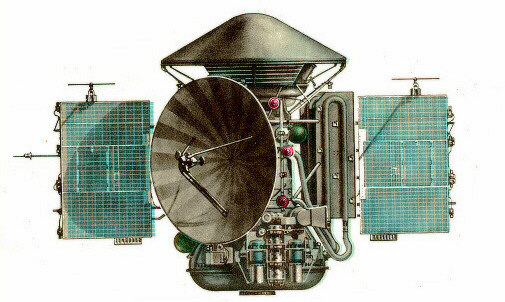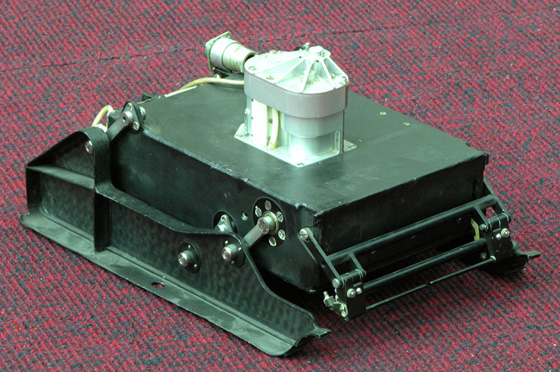The world’s first Soviet Mars rovers had name: Instrument of evaluation of maneuverability – Mars (PrOP-M, local abbreviation). They were designed and manufactured by VNIItransmash, chief designer – Alexander L. Kemurdzhian.[1] Two automatic rovers reached the Martian surface during “Mars-2” and “Mars-3” missions in 1971. None of them fulfilled its mission.[3]
“Mars-2” automatic interplanetary station was launched on May 19, 1971, landing craft crash-landed on the planet on November 27, 1971. “Mars-3” automatic interplanetary station was launched on May 28, 1971, landing craft has stopped transmission of the signal (presumably it was broke because of the dust storm) 20 seconds after the landing on December 2, 1971. The presence of mobile devices in these missions was hidden for 20 years.[3]
PrOP-M belongs to a group of planetary rovers, which have a wired connection to the device, which took them to the surface of the planet. Wired communication is intended to connect the power supply and transmission of telemetry data from planetary rovers. Such rovers can be quite simple and easy, ones can be used to obtain data about the surface near the landing craft.[24]
Testing of PrOP-M. [18]
PrOP-M is designed to study the physical and mechanical properties of the soil of the planet using dynamic penetrometer and radiation densitometer. For move it is equipped with ski-walking driver. Stir in the given direction is carried out by alternate transfer of ski bearings and frame. The turn is realized by moving the bearings in opposite directions. When it touches the obstacles by one of bumpers, the automatic maneuvering of rover happens in accordance with a specified algorithm: give it back, turn on an angle, moving forward. Ski-walking propulsion provides high traction characteristics on the granular soil. The main parameters of planetary rover: weight – 3.5 kg, dimensions – 0.25 x 0.22 x 0.125 m, radius of action – up to 15 m.[24] The speed of movement – 1 meter/hour (after moving to a meter, the rover should stop to receive control commands from the Earth).[1]
Although the landing modules of “Mars-2” and “Mars-3” were out of order, their accompanying orbiters successfully completed their missions and transmitted to Earth the valuable scientific data. The orbiters continued their work until August 1972, when the Soviet Union announced the end of the mission.[3] “Mars-2” landing craft became the first manmade object which was brought to the surface of Mars. Not flown copy of the rover is on display at the museum of Gas Dynamics Laboratory at the Peter and Paul Fortress in St. Petersburg.[1]
References:
1. Прибор оценки проходимости — Марс. — Mode of access: http://ru.wikipedia.org/wiki/%D0%9F%D1%80%D0%B8%D0%B1%D0%BE%D1%80_%D0%BE%D1%86%D0%B5%D0%BD%D0%BA%D0%B8_%D0%BF%D1%80%D0%BE%D1%85%D0%BE%D0%B4%D0%B8%D0%BC%D0%BE%D1%81%D1%82%D0%B8_%E2%80%94_%D0%9C%D0%B0%D1%80%D1%81.
2. Файл:Mars3 iki.jpg. — Mode of access: http://ru.wikipedia.org/wiki/%D0%A4%D0%B0%D0%B9%D0%BB:Mars3_iki.jpg.
3. КРАСНЫЙ КОСМОС. Первый в истории марсоход достиг Марса в 1971 году. — Mode of access: http://www.infuture.ru/news.php?news_id=155.
4. Марсоход. — Mode of access: http://ru.wikipedia.org/wiki/%D0%9C%D0%B0%D1%80%D1%81%D0%BE%D1%85%D0%BE%D0%B4.
5. Марсохід. — Mode of access: http://uk.wikipedia.org/wiki/%D0%9C%D0%B0%D1%80%D1%81%D0%BE%D1%85%D1%96%D0%B4.
6. Планетохід. — Mode of access: http://uk.wikipedia.org/wiki/%D0%9F%D0%BB%D0%B0%D0%BD%D0%B5%D1%82%D0%BE%D1%85%D1%96%D0%B4.
7. Файл:Rover Rus Mars3.jpg. — Mode of access: http://ru.wikipedia.org/wiki/%D0%A4%D0%B0%D0%B9%D0%BB:Rover_Rus_Mars3.jpg.
8. Марс (космическая программа) . — Mode of access: http://ru.wikipedia.org/wiki/%D0%9C%D0%B0%D1%80%D1%81_%28%D0%BA%D0%BE%D1%81%D0%BC%D0%B8%D1%87%D0%B5%D1%81%D0%BA%D0%B0%D1%8F_%D0%BF%D1%80%D0%BE%D0%B3%D1%80%D0%B0%D0%BC%D0%BC%D0%B0%29.
9. Марс-2. — Mode of access: http://ru.wikipedia.org/wiki/%D0%9C%D0%B0%D1%80%D1%81-2.
10. Марс-3. — Mode of access: http://ru.wikipedia.org/wiki/%D0%9C%D0%B0%D1%80%D1%81-3.
11. Марс-3. — Mode of access: http://uk.wikipedia.org/wiki/%D0%9C%D0%B0%D1%80%D1%81-3.
12. Космические аппараты серии Марс-71 НПО им. С.А.Лавочкина. — Mode of access: http://www.laspace.ru/rus/mars23.php.
13. Mars 2 // NASA – NSSDC – Spacecraft – Details. — Mode of access: http://nssdc.gsfc.nasa.gov/nmc/masterCatalog.do?sc=1971-045A.
14. Mars 2 Lander // NASA – NSSDC – Spacecraft – Details. — Mode of access: http://nssdc.gsfc.nasa.gov/nmc/masterCatalog.do?sc=1971-045D.
15. Mars 3 // NASA – NSSDC – Spacecraft – Details. — Mode of access: http://nssdc.gsfc.nasa.gov/nmc/spacecraftDisplay.do?id=1971-049A.
16. Mars 3 Lander // NASA – NSSDC – Spacecraft – Details. — Mode of access: http://nssdc.gsfc.nasa.gov/nmc/spacecraftDisplay.do?id=1971-049F.
17. The VSM: Martian probes. — Mode of access: http://vsm.host.ru/e_mars.htm.
18. From Moonrover to Marsrover. Part 1 of 2. — Mode of access: http://www.youtube.com/embed/nF2gU3_9WC4.
19. Марс-2,-3. M71 – unmanned landers, orbiters and first marsrover launched to Mars in 1971. — Mode of access: http://www.youtube.com/embed/a-W-4X3zSoI.
20. Mars. — Mode of access: http://en.wikipedia.org/wiki/Mars.
21. Марс. — Mode of access: http://uk.wikipedia.org/wiki/%D0%9C%D0%B0%D1%80%D1%81_%28%D0%BF%D0%BB%D0%B0%D0%BD%D0%B5%D1%82%D0%B0%29.
22. Марс. — Mode of access: http://ru.wikipedia.org/wiki/%D0%9C%D0%B0%D1%80%D1%81_%28%D0%BF%D0%BB%D0%B0%D0%BD%D0%B5%D1%82%D0%B0%29.
23. Tank on the Moon. — Mode of access: http://science.discovery.com/tv/tank/tank.html .
24. Планетоходы / А.Л. Кемурджиан, В.В. Громов, И.Ф. Кажукало [и др.]; под ред. А.Л. Кемурджиана. — [2-е изд.]. — М.: Машиностроение, 1993. – 400с.
25. Бабакин, Георгий Николаевич. — Mode of access: http://ru.wikipedia.org/wiki/%D0%91%D0%B0%D0%B1%D0%B0%D0%BA%D0%B8%D0%BD,_%D0%93%D0%B5%D0%BE%D1%80%D0%B3%D0%B8%D0%B9_%D0%9D%D0%B8%D0%BA%D0%BE%D0%BB%D0%B0%D0%B5%D0%B2%D0%B8%D1%87.
26. НПО имени С. А. Лавочкина. — Mode of access: http://ru.wikipedia.org/wiki/%D0%9D%D0%9F%D0%9E_%D0%9B%D0%B0%D0%B2%D0%BE%D1%87%D0%BA%D0%B8%D0%BD%D0%B0.
27. ФГУП «Научно-производственное объединение им. С. А. Лавочкина». — Mode of access: http://www.laspace.ru.
28. Кемурджиан, Александр Леонович. — Mode of access: http://ru.wikipedia.org/wiki/%D0%9A%D0%B5%D0%BC%D1%83%D1%80%D0%B4%D0%B6%D0%B8%D0%B0%D0%BD,_%D0%90%D0%BB%D0%B5%D0%BA%D1%81%D0%B0%D0%BD%D0%B4%D1%80_%D0%9B%D0%B5%D0%BE%D0%BD%D0%BE%D0%B2%D0%B8%D1%87.
29. ОАО «ВНИИтрансмаш». — Mode of access: http://www.vniitransmash.ru/.
30. Газодинамическая лаборатория. — Mode of access: http://ru.wikipedia.org/wiki/%D0%93%D0%94%D0%9B.
1 This file is in the public domain because it was created by NASA.
2 Author published this work under the Creative Commons Attribution-Share Alike 3.0 Unported.

